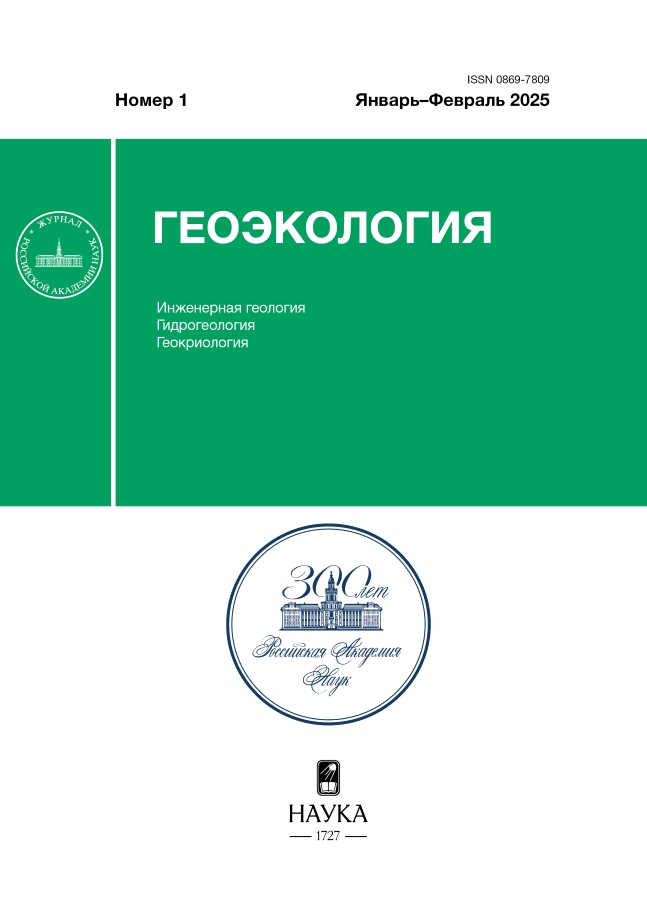Гибридное моделирование на основе LUR подхода вариаций распределения тяжелых металлов в верхнем слое почвы на примере г. Тарко-Сале
- Авторы: Баглаева Е.М.1, Буевич А.Г.1, Шичкин А.В.1, Сергеев А.П.1, Буторова А.С.1
-
Учреждения:
- Институт промышленной экологии Уральского отделения Российской академии наук (ИПЭ УрО РАН)
- Выпуск: № 1 (2025)
- Страницы: 87-96
- Раздел: МЕТОДОЛОГИЯ И МЕТОДИКА ИССЛЕДОВАНИЙ
- URL: https://journals.eco-vector.com/0869-7809/article/view/684729
- DOI: https://doi.org/10.31857/S0869780925010097
- EDN: https://elibrary.ru/DOFNYZ
- ID: 684729
Цитировать
Полный текст
Аннотация
Для оценки вариаций пространственного загрязнения тяжелыми металлами верхнего слоя городской почвы использована гибридная модель Land Use Regression (LUR) и регрессионный кригинг (RK). Модель построена на основе данных мониторинга содержания никеля и марганца в верхнем слое почвы арктического г. Тарко-Сале. Предложенный LUR и RK метод моделирования загрязнения автотранспортом верхнего слоя почвы может быть использован для любой территории. Применение RK улучшает точность LUR модели: корреляция тестового и предсказанного наборов увеличилась на 7% для никеля и на 17% для марганца, а относительная среднеквадратическая ошибка RRMSE уменьшалась на 10% для обоих элементов. Результаты гибридного моделирования LUR с регрессионным кригингом позволили определить, что распределение марганца и никеля в верхнем слое почвы города не зависит от автотранспорта. Это свидетельствует о природном происхождении марганца и никеля в городской почве в отсутствие других источников загрязнения. Последовательное включение различных источников загрязнения в модель LUR является способом оценки вклада каждого из выбранных источников в загрязнение выбранным элементом.
Полный текст
Об авторах
Е. М. Баглаева
Институт промышленной экологии Уральского отделения Российской академии наук (ИПЭ УрО РАН)
Автор, ответственный за переписку.
Email: e.m.baglaeva@urfu.ru
Россия, Екатеринбург
А. Г. Буевич
Институт промышленной экологии Уральского отделения Российской академии наук (ИПЭ УрО РАН)
Email: bag@ecko.uran.ru
Россия, Екатеринбург
А. В. Шичкин
Институт промышленной экологии Уральского отделения Российской академии наук (ИПЭ УрО РАН)
Email: and@ecko.uran.ru
Россия, Екатеринбург
А. П. Сергеев
Институт промышленной экологии Уральского отделения Российской академии наук (ИПЭ УрО РАН)
Email: sergeev@ecko.uran.ru
Россия, Екатеринбург
А. С. Буторова
Институт промышленной экологии Уральского отделения Российской академии наук (ИПЭ УрО РАН)
Email: a.s.butorova@urfu.ru
Россия, Екатеринбург
Список литературы
- Антропов К.М., Вараксин А.Н. Оценка загрязнения атмосферного воздуха г. Екатеринбурга диоксидом азота методом Land Use Regression // Экологические системы и приборы. 2011. №8. C. 47–54.
- Буевич А.Г., Сафина А.М., Сергеев А.П. и др. Анализ статистических зависимостей распределения загрязняющих веществ в поверхностном слое почвы урбанизированных территорий с применением математических моделей (LUR метод) // Геоэкология. 2015. №3. С. 268–279.
- Медведев А.Н., Медведев М.А. О применении подхода Land Use Regression для моделирования площадного загрязнения снега при малом количестве точек наблюдения // XI Междунар. конф. «Российские регионы в фокусе перемен». Екатеринбург, 17–19 ноября 2016 г.: сб. докладов. Екатеринбург: Издательство УМЦ УПИ, 2016. Ч. 1. С. 487–494.
- Сергеев А.П., Баглаева Е.М., Субботина И.Е. Загрязнение почв города Тарко-Сале тяжелыми металлами // Геоэкология. 2014. №1. С. 28–36.
- Aguilera I., Sunyer J., Fernandez-Patier R., Hoek G. et al. Estimation of outdoor NOx, NO2 and BTEX exposure in a cohort of pregnant women using land use regression modeling // Environ. Sci. Technol. 2008. V. 42. P. 815–821.
- Brauer M., Hoek G., van Vliet P., Meliefste K. et al. Estimating long-term average particulate air pollution concentrations: application of traffic indicators and geographic information systems // Epidemiology. 2003. V. 14. P. 228–239.
- Briggs D.J., de Hoogh C., Gulliver J., Wills J. et al. A regression-based method for mapping trafficrelated air pollution: application and testing in four contrasting urban environments // Sci. Total. Environ. 2000. V. 253(1–3). P. 151–167.
- Carr D., von Ehrenstein O., Weiland S., Wagner C. et al. Modeling annual benzene, toluene, NO2, and soot concentrations on the basis of road traffic characteristics // Environ. Res. 2002. V. 90. P. 111–118.
- Hoek G., Beelen R., de Hoogh K., Vienneaue D. et al. A review of land-use regression models to assess spatial variation of outdoor air pollution // Atmos. Environ. 2008. V. 36. P. 4077–4088.
- Kashima S., Yorifuji T., Tsuda T., Doi H. Application of land use regression to regulatory air quality data in Japan // Sci Total Environ. 2009. V. 407(8). P. 3055–3062.
- Liu Y., Song S., Bi C., Zhao J., Xi, D., Su Z. Occurrence, Distribution and Risk Assessment of Mercury in Multimedia of Soil-Dust-Plants in Shanghai, China // Int. J. Environ. Res. Public Health. 2019. V. 16. 3028. https://doi.org/10.3390/ijerph16173028
- Moore D.K., Jerrett M., Mack W.J., Kunzli N. A land use regression model for predicting ambient fine particulate matter across Los Angeles, CA // J. Environ. Monitor. 2007. V. 9. P. 246–252.
- Ross Z., English P.B., Scalf R., Gunier R. et al. Nitrogen dioxide prediction in Southern California using land use regression modeling: potential for environmental health analyses // J. Expo. Sci. Environ. Epidemiol. 2006. V. 16. P. 106–114.
- Smith L., Mukerjee S., Gonzales M., Stallings C. et al. Use of GIS and ancillary variables to predict volatile organic compound and nitrogen dioxide levels at unmonitored locations // Atmos. Environ. 2006. V. 40. P. 3773–3787.
- Stedman J., Vincent K., Campbell G., Goodwin J., Downing C. New high resolution maps of estimated background ambient NOx and NO2 concentrations in the U.K. // Atmos. Environ. 1997. V. 31. P. 3591–3602.
- Taylor K. Summarizing multiple aspects of model performance in a single diagram // J. Geophys. Res. 2001. V. 106. P. 7183–7192. https://doi.org/10.1029/2000JD900719
Дополнительные файлы














